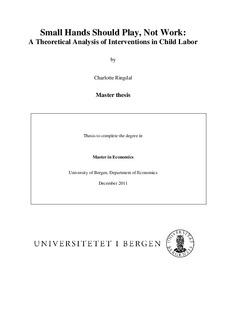Small Hands Should Play, Not Work: A Theoretical Analysis of Interventions in Child Labor
Master thesis

Permanent lenke
http://hdl.handle.net/11250/2474739Utgivelsesdato
2011-01-01Metadata
Vis full innførselSamlinger
- Publications [1488]
Originalversjon
Master in Economics. Bergen: University of Bergen 102 p.Sammendrag
Twelve hours a day, 7 days a week, there are 150 million children below the age of 15 working to make the clothes we wear, the carpets on our floors and the phones in our pockets. Most of these children do not have a choice: the alternative is worse. In this thesis, I use economic models to study how interventions (such as increased educational opportunities, firmer legislation, international conventions and product labeling) affect the incidence of child labor. I find that most interventions are likely to reduce the incidence of child labor either at a national level, a local level or in a specific industry. Some interventions (such as bans) are more likely to reduce the welfare of children than others (such as increased educational opportunities). It appears that if households do not chose by themselves to withdraw children from the labor market and are not given any form of compensation for lost income, the welfare of households (and thus the children as well) is reduced. Having this in mind, I take a closer look at one intervention in the carpet sector in Nepal: the Nepal GoodWeave Foundation. This organization labels carpets that are exported to countries such as Germany and the U.S. I find that GoodWeave is successful in reducing child labor in the factories that carry their label. At the same time, the organization helps to maintain the welfare of the children through education programs, in addition to preventing child labor by offering the children of carpet workers access to kindergartens and schools. Unfortunately, the scope of the program is too small to eliminate child labor throughout the carpet sector in Nepal.